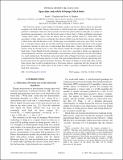Spacetime and orbits of bumpy black holes
Author(s)
Vigeland, Sarah Jane; Hughes, Scott A
DownloadVigeland-2010-Spacetime and orbits of bumpy black holes.pdf (377.5Kb)
PUBLISHER_POLICY
Publisher Policy
Article is made available in accordance with the publisher's policy and may be subject to US copyright law. Please refer to the publisher's site for terms of use.
Terms of use
Metadata
Show full item recordAbstract
Our Universe contains a great number of extremely compact and massive objects which are generally accepted to be black holes. Precise observations of orbital motion near candidate black holes have the potential to determine if they have the spacetime structure that general relativity demands. As a means of formulating measurements to test the black hole nature of these objects, Collins and Hughes introduced “bumpy black holes”: objects that are almost, but not quite, general relativity’s black holes. The spacetimes of these objects have multipoles that deviate slightly from the black hole solution, reducing to black holes when the deviation is zero. In this paper, we extend this work in two ways. First, we show how to introduce bumps which are smoother and lead to better behaved orbits than those in the original presentation. Second, we show how to make bumpy Kerr black holes—objects which reduce to the Kerr solution when the deviation goes to zero. This greatly extends the astrophysical applicability of bumpy black holes. Using Hamilton-Jacobi techniques, we show how a spacetime’s bumps are imprinted on orbital frequencies, and thus can be determined by measurements which coherently track the orbital phase of a small orbiting body. We find that in the weak field, orbits of bumpy black holes are modified exactly as expected from a Newtonian analysis of a body with a prescribed multipolar structure, reproducing well-known results from the celestial mechanics literature. The impact of bumps on strong-field orbits is many times greater than would be predicted from a Newtonian analysis, suggesting that this framework will allow observations to set robust limits on the extent to which a spacetime’s multipoles deviate from the black hole expectation.
Date issued
2010-01Department
Massachusetts Institute of Technology. Department of Physics; MIT Kavli Institute for Astrophysics and Space ResearchJournal
Physical Review D
Publisher
American Physical Society
Citation
Vigeland, Sarah J. and Scott A. Hughes. "Spacetime and orbits of bumpy black holes." Physical Review D 81.2 (2010): 024030. © 2010 The American Physical Society
Version: Final published version
ISSN
1550-7998
1550-2368